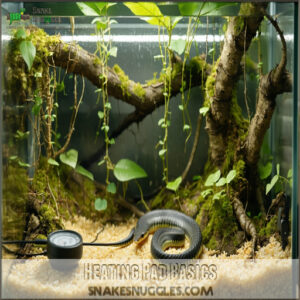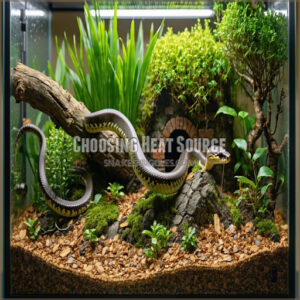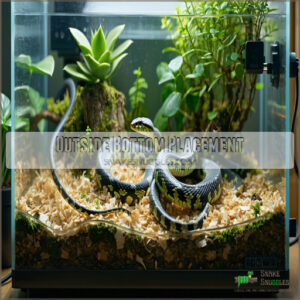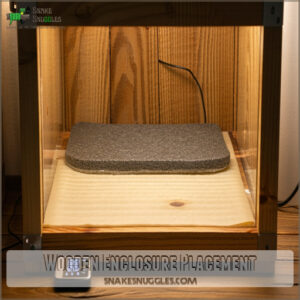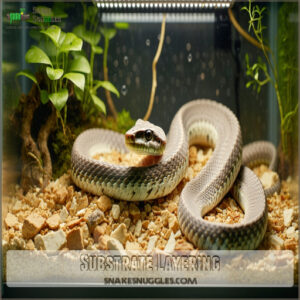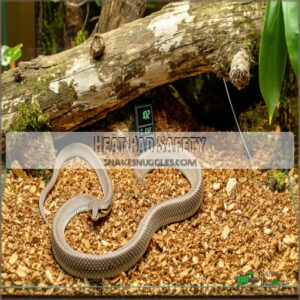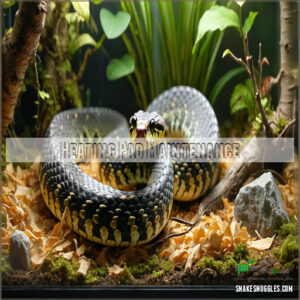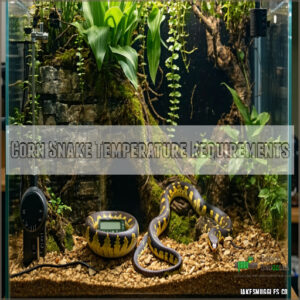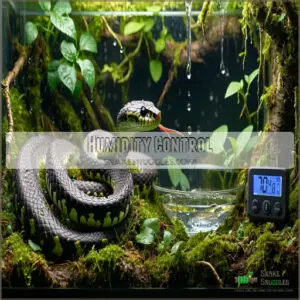This site is supported by our readers. We may earn a commission, at no cost to you, if you purchase through links.
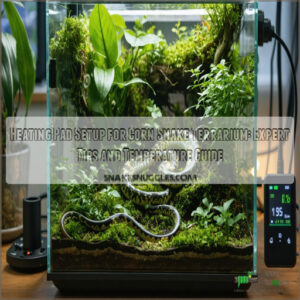 You’ll want to set up your corn snake’s heating pad on one-third of the terrarium’s bottom, creating a cozy warm zone without cooking your scaly friend.
You’ll want to set up your corn snake’s heating pad on one-third of the terrarium’s bottom, creating a cozy warm zone without cooking your scaly friend.
Pick an under-tank heater that matches your enclosure size – think small for 10-gallon tanks, medium for 20-gallon setups.
Place it outside the tank, leaving a slight air gap to prevent hotspots, and always use a thermostat to maintain safe temperatures.
Layer substrate thinly above the heated area, and monitor both warm and cool sides with digital probes to verify proper thermal gradients, getting these temperature zones just right is like creating a five-star reptile resort.
Table Of Contents
- Key Takeaways
- Heating Pad Basics
- Choosing Heat Source
- Heat Pad Placement
- Heat Pad Safety
- Creating Thermal Gradient
- Heating Pad Maintenance
- Optimal Heat Pad Setup
- Frequently Asked Questions (FAQs)
- Is a heat pad necessary for a corn snake?
- How do you heat a corn snake tank?
- How do you heat a corn snake cage?
- How do you keep a corn snake warm?
- How do you make a corn snake terrarium?
- What temperature should a corn snake terrarium be?
- Where do you put the heat mat on a corn snake?
- Are heat mats good for corn snakes?
- Where do you put the heating pad in a snake tank?
- What is the proper heating for a corn snake?
- Conclusion
Key Takeaways
- You’ll need to place your heating pad on one-third of the terrarium’s bottom, creating a thermal gradient with a warm side (85-90°F) and cool side (75-80°F) for proper thermoregulation.
- You must use a thermostat to regulate the heat pad’s temperature and prevent burns – it’s not optional for your snake’s safety and comfort.
- You should maintain a thin substrate layer above the heating pad to ensure effective heat transfer while preventing direct contact between your snake and the heat source.
- You’ll want to check temperatures daily and clean your heating pad monthly, while monitoring both the warm and cool zones with digital probe thermometers for accuracy.
Heating Pad Basics
A heating pad is a reliable way to provide the consistent ground heat your corn snake needs to stay healthy.
By understanding the different types, sizes, and materials, you can choose the right pad to maintain safe and comfortable temperatures in the enclosure.
Heat Pad Types
When picking a heat pad for your corn snake, it’s essential to know the types.
Most options include under tank heaters, adhesive pads, and flexible heat mats.
You can compare various corn snake heat pad products online.
Each provides efficient thermal control and proper heat distribution.
Look for materials that offer energy efficiency, like iPower or Zilla mats.
These heat sources make sure your snake stays cozy and healthy.
Heat Pad Sizes
Choosing the right heating pad size for a corn snake is key for maintaining temperature control and snake comfort.
You can find a variety of corn snake heating pad options online.
Match the under tank heater to your terrarium size:
- Small Pads: Ideal for hatchlings or 10-gallon tanks.
- Medium Pads: Perfect for 20-gallon enclosures.
- Large Pads: Suitable for 40-gallon setups.
- Custom Sizes: Make sure proper enclosure fit and heat output.
Heat Pad Materials
When exploring heat pad materials, prioritize safety and efficiency for your corn snake.
Look for materials like PVC or other heat-resistant layers, which evenly distribute heat without hotspots.
Avoid flammable or poorly insulated options, as they may risk overheating.
The best heat pad for corn snakes balances conductivity and insulation, ensuring your terrarium heating pad setup remains safe and reliable.
Choosing Heat Source
When choosing a heat source for your corn snake, focus on options that provide consistent and safe warmth.
Heat pads, radiant heat panels, and ceramic heat emitters each offer unique benefits that support proper thermoregulation.
They are essential for creating an environment that allows your corn snake to thrive, by providing the necessary warmth for its survival, and consistent temperature is crucial.
Heat Pads and Mats
Using a heating pad for your corn snake provides consistent warmth in its terrarium.
These heat sources provide reliable thermal control, promoting snake comfort.
Corn snakes require proper temperature gradients for ideal health.
Common pad materials include durable, moisture-resistant options like PVC.
- Benefits of heating mats:
- Gentle ground heat
- Multiple mat sizes available
- Affordable setup costs
- Easy terrarium heating pad setup
- Prevents overheating risks with reliable thermal control
Radiant Heat Panels
Radiant heat panels are a great choice for providing consistent, top-down heat in your corn snake terrarium.
These panels, made from materials like ceramic or metal, efficiently warm the habitat without bright light.
They distribute heat evenly, ensuring a stable environment. Choose an energy-efficient model, install it securely above the enclosure, and pair it with a thermostat to maintain safe temperatures.
Ceramic Heat Emitters
Ceramic heat emitters are great for steady, light-free warmth in your corn snake’s terrarium.
Unlike heat lamps, they focus on heat distribution without altering light cycles, making them ideal for nocturnal species.
Use a thermostat for corn snake terrarium setups to manage wattage control and thermal output, and always check emitter safety to avoid overheating or burns, ensuring the thermostat is used correctly.
Heat Pad Placement
Placing the heat pad correctly is essential to maintaining your corn snake’s ideal temperature gradient.
You’ll need to position it outside the enclosure or make sure safe installation if you’re using a wooden tank.
Outside Bottom Placement
For proper heating pad placement, position your corn snake heat mat underneath one-third of the enclosure. This setup provides a thermal gradient for your snake to stay comfy and safe.
Follow these tips:
- Place the heating pad directly below the warm side.
- Leave a slight gap for airflow, preventing overheating.
- Use a thin substrate layer for even heat distribution.
By following these guidelines, you can ensure your corn snake has a safe and comfortable environment, with a proper heating pad placement.
Wooden Enclosure Placement
When using a wooden enclosure, place the heating pad inside on one side for better heat distribution.
Wood blocks heat radiation, so this technique ensures effective warming and thermal insulation.
Protect your corn snake with safe installation methods.
Here’s a quick guide:
| Task | Material Needed | Tip |
|---|---|---|
| Heat pad placement | Heating pad | Position under one-third of floor. |
| Insulation layer | Shelf liner/substrate | Reduce direct contract risk. |
| Temp monitoring | Thermostat/thermometer | Maintain consistent temperatures. |
To ensure the well-being of your corn snake, it is crucial to follow these guidelines carefully, focusing on effective warming and proper installation to create a safe environment.
Substrate Layering
For a proper corn snake heating pad setup, substrate layering is key to safety and humidity.
Add a thin layer of substrate over the heat pad for better heat transfer. Use humidity-friendly materials like aspen or coconut fiber.
Avoid thick bedding, as it blocks heat. Maintain moisture levels to prevent dryness or overheating.
Proper heat source management is essential for reptile safety.
Heat Pad Safety
You’ve got to make heat pad safety a priority to protect your snake from burns and overheating.
Using a thermostat, monitoring temperatures, and creating a barrier between the pad and your snake are all essential steps to keep the enclosure safe.
Thermostat Regulation
A thermostat is essential for temperature control, preventing dangerous heat spikes on your heat pad.
Set it to maintain a steady temperature gradient, with warm side settings matching corn snake needs.
Proper heat source placement is important for thermoregulation.
Use a digital probe thermometer to monitor heat cycles accurately, and always confirm safety features, like automatic shutoff, to assure reliable regulation.
This keeps your snake safe and comfortable.
Temperature Monitoring
To keep your snake comfy and healthy, monitor its temperature daily.
Use digital probe thermometers at the warm and cool sides for accurate readings. You can find a variety of snake terrarium thermometers online.
Follow these tips:
- Place thermometers near heat sources and hiding spots.
- Adjust the thermostat for consistent gradient control.
- Log temperatures regularly.
- Inspect thermal sensors.
- Confirm all zones meet temperature requirements to keep your snake healthy and ensure a proper temperature environment.
Burn Prevention
Thermal protection starts with temperature control.
Use a thermostat to regulate heat mats and prevent burn risks or thermal burns.
Add safe materials like a thin substrate layer for injury prevention.
Heat guards can block direct contact with the heat source.
Regular checks reduce heat stress and maintain heat lamp safety, keeping your snake’s enclosure safe and cozy.
Creating Thermal Gradient
You’ll need to create essential temperature zones in your corn snake’s terrarium by placing the heating pad on one side of the enclosure.
Your snake will move between the warm side (85-90°F) and cool side (75-80°F) to regulate its body temperature naturally.
Warm Side Temperature
You’ll want to maintain your corn snake’s warm side temperature between 80-85°F using a reliable heating pad.
This temperature range mimics their natural habitat and supports healthy digestion.
For ideal thermal gradients, position your under tank heater to cover one-third of the terrarium’s bottom.
Learn more about proper heat mat placement for your snake’s enclosure.
When setting up your corn snake terrarium heat, create a basking spot reaching 88-92°F for proper thermoregulation.
This setup will help ensure your corn snake has the right environment to thrive, with a suitable temperature range and thermal gradients.
Cool Side Temperature
Your corn snake needs a proper cool side temperature to maintain their natural thermoregulation cycle.
The cool zone helps your snake regulate its body temperature effectively through daily temperature cycles.
- Maintain temperatures between 75-80°F (24-27°C)
- Place thermometers at ground level for accurate readings
- Monitor humidity levels in cool zones (40-50%)
- Position water dishes on the cool side
Remember to check temperatures daily for best snake comfort and health.
Basking Spot Temperature
Your snake’s basking spot needs to reach 88-92°F for ideal health.
Setting up this warm zone with your heating pad creates the perfect spot for your corn snake to digest meals and regulate its body temperature.
Place the heat mat under one-third of the tank’s floor, and always use a thermostat to maintain safe temperatures.
Monitor the basking area daily with a reliable thermometer.
Heating Pad Maintenance
You’ll need to check your corn snake’s heating pad daily and clean it monthly to make sure it’s working safely and effectively.
Regular maintenance, including temperature monitoring and substrate changes, will help prevent issues that could harm your scaly friend, through regular actions.
Daily Temperature Checks
Now that you’ve set up the perfect temperature gradient, keeping tabs on those daily readings becomes your morning ritual.
You’ll want to maintain a temperature log to track any fluctuations in your corn snake’s habitat. Selecting the right heating pad type is important for maintaining a proper thermal gradient.
- Check temperatures at three consistent times daily: morning, afternoon, and evening
- Record both warm and cool side readings in your temperature log
- Note any unusual heat cycles or thermal monitoring concerns
Remember, proper thermoregulation keeps your scaly friend happy and healthy, and it’s crucial for creating a perfect environment.
Monthly Heat Pad Cleaning
While daily temperature monitoring keeps your snake cozy, you’ll need to clean that heating pad monthly.
Unplug the pad and let it cool completely. Use a damp cloth with gentle reptile-safe disinfectant to wipe the pad’s surface.
Avoid getting water near electrical components. A quick monthly cleaning prevents dust buildup and makes sure your heat pad works efficiently for your corn snake’s comfort.
Substrate Replacement
After cleaning your heating pad, it’s time to refresh your snake’s bedding.
Replace substrate when it becomes soiled or compacted, typically every 4-6 weeks.
Here’s your quick guide:
- Remove old substrate completely and check heating pad’s surface
- Add fresh aspen or coconut fiber bedding, keeping it thin above the heating pad
- Monitor humidity levels for 24 hours after replacement
This routine helps maintain proper heat transfer while keeping your corn snake’s environment clean and comfortable with a clean heating pad.
Optimal Heat Pad Setup
You’ll need to place your heat pad on the outside bottom of your corn snake’s terrarium, covering one-third of the floor space for an ideal thermal gradient.
To prevent burns and maintain the perfect temperature range of 75-85°F, you’ll want to connect the heat pad to a reliable thermostat and add a thin layer of substrate above the heated area.
Corn Snake Temperature Requirements
Throughout the day, your corn snake needs distinct temperature zones for best health.
Maintain the basking area at 90°F with a UVI of 2.0-3.0, while keeping the cool zone between 75-82°F.
You’ll want to drop temperatures to 75°F at night to mimic their natural habitat.
A 13-hour summer light cycle and 11-hour winter cycle supports their natural hormonal rhythms and activity patterns.
Humidity Control
While maintaining proper temperatures helps your corn snake thrive, keeping the right humidity is just as important.
Proper snake terrarium humidity control is essential for their health.
Your snake needs 65-75% humidity to stay healthy.
You’ll want to set up a humid hide filled with moisture-retaining substrate, position water bowls strategically, and use misting systems or fog machines when needed.
Monitor levels with a calibrated hygrometer to prevent respiratory issues and maintain proper shedding.
Enclosure Size Considerations
When selecting your corn snake tank size, remember that heat mats work best in smaller enclosures but mightn’t suffice for larger setups.
You’ll want to match your heat pad size to your tank dimensions – covering about one-third of the floor space.
For effective heating, choose mats ranging from 4×5 inches for hatchlings to 8×18 inches for adults, and consider upgrading to heat lamps for larger vivariums.
Frequently Asked Questions (FAQs)
Is a heat pad necessary for a corn snake?
Yes, you’ll need a heat pad for your corn snake’s survival.
It’s an essential tool that helps maintain proper body temperature and digestion.
Without one, your snake can’t regulate its temperature effectively, and this is a critical aspect of its survival.
How do you heat a corn snake tank?
You’ll need a heating pad on one side of the tank for a warm zone (85-90°F) and a cool side (75-80°F).
Install a thermostat to control temperature and prevent overheating.
How do you heat a corn snake cage?
You’ll want to install a heating pad under one-third of the tank, controlled by a thermostat set to 85°F.
Add a ceramic heat lamp above for basking, creating the perfect temperature gradient.
How do you keep a corn snake warm?
Holy smokes, you’ll need to maintain your corn snake’s warmth using a temperature gradient.
Set up a basking spot at 85-90°F and a cooler side at 75-80°F.
You’ll want a thermostat for control.
How do you make a corn snake terrarium?
Set up a 20-30 gallon glass terrarium with secure lid, heating pad, thermometer, two hide boxes, and aspen substrate. Add climbing branches and water bowl. Maintain 75-85°F temperature gradient.
What temperature should a corn snake terrarium be?
Like a well-balanced thermostat, your corn snake’s terrarium should maintain two distinct zones: a warm side at 85-90°F and a cool side at 75-80°F.
You’ll need a temperature gradient for healthy thermoregulation.
Where do you put the heat mat on a corn snake?
Place your heat mat under the terrarium’s bottom, covering one-third of the floor on one side.
You’ll need to elevate the corners slightly for airflow and use a thermostat to prevent overheating.
Are heat mats good for corn snakes?
As reliable as a trusty thermostat, heat mats are excellent for corn snakes.
They’re safe when properly regulated, provide consistent belly heat your snake needs, and work well in various enclosure setups, which makes them a great option because they are safe.
Where do you put the heating pad in a snake tank?
You’ll want to mount your heating pad underneath the tank’s exterior bottom, covering one-third of the floor area. Leave space between corners, and always use a thermostat to prevent overheating.
What is the proper heating for a corn snake?
You’ll need a temperature gradient from 75-85°F in your corn snake’s enclosure.
Set up a heating pad with thermostat on one side, maintaining 85-90°F for the warm side and 75-80°F for cooling.
Conclusion
Just like programming your smart home, setting up your corn snake’s heating pad requires careful attention to detail.
You’ll find that creating the perfect thermal environment isn’t rocket science – it’s about understanding your snake’s needs and implementing the right heating pad setup for your corn snake terrarium.
Remember to regularly check temperatures, maintain your equipment, and make adjustments as needed.
With proper heat pad placement and monitoring, you’re creating a comfortable habitat where your scaly friend can thrive.
- https://thepetenthusiast.com/corn-snake-heating-pad/
- https://happyserpent.com/snake-information/best-snake-heating-pads/
- https://www.xyzreptiles.com/correctly-using-reptile-heating-pad/
- https://www.reddit.com/r/snakes/comments/w1psjo/what_is_the_best_way_to_attach_a_heat_mat_to_the/
- https://www.yelp.com/biz/the-basking-spot-reptiles-and-supplies-glendora

